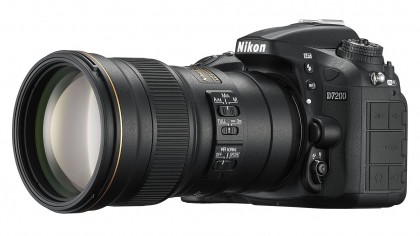Nikon D7200 brings a handful of new features but no breakthroughs
Anyone waiting for a Canon EOS 7D Mark II beater from Nikon is going to have to wait some more

The D7200 is Nikon's new top APS-C format DSLR, but while it does boast some useful improvements over the D7100 before it, it feels like a mid-term update rather than a new camera.
It's certainly no rival for the Canon EOS 7D Mark II announced last September. There's still a gap at the top of the Nikon range for a high-speed semi-pro APS-C format camera – the D400? – but still no sign that Nikon's going to make one.
Instead, the D7200 is more likely to appeal to enthusiasts and non-professionals, just like the Canon EOS 70D.
D7100 vs D7200: what's new?
It's been two years since the D7100 was launched, and on the face of it the D7200 brings few major changes. Externally, it's identical, with the same dimensions, weight, rear screen and viewfinder.
The sensor looks like the same 24-megapixel OLPF-free unit found in the D7100, though there are signs that some details have changed. Nikon quotes a resolution of 24.2 megapixels, versus the 24.1 megapixels of the D7100, though the final image size is exactly the same at 6,000 x 4,000 pixels.

Whether or not the sensor has been re-developed, the camera's internal processor has certainly been upgraded. The D7100 used an Expeed 3 processor, while the D7200 swaps to Expeed 4.
Normally, a processor upgrade brings improvements in continuous shooting speeds and high-ISO capability, and the latter has certainly improved. The D7200 now has a native ISO range of 100-25600, which is 2EV higher than the ISO 100-6400 of the D7100. The D7100 goes up to ISO 25600 in expanded mode, but the D7200 can pull this trick too, offering a Hi2 setting of 102400.
Sign up for breaking news, reviews, opinion, top tech deals, and more.
The D7200's continuous shooting speeds are the same as the D7100's – 6fps at full resolution and 7fps in the camera's 1.3x 'crop' mode. This is a little disappointing, but the D7200 has addressed a serious weakness in the D7100 – its small buffer capacity. Nikon now quotes a capacity of 27 RAW files or 100 JPEGs in a burst, which is much better – though the RAW figure is for smaller 12-bit NEF files, not the 14-bit files most photographers would choose for outright quality.
Why the 1.3x crop mode?
This was introduced with the D7100, and it does a couple of things. First, it extends the reach of telephoto lenses, and the 24-megapixel OLPF-free sensor has enough resolution to handle cropping pretty well.

Second, it allows the 51 AF points to completely fill the frame. In fact, this is another area where Nikon has made slight improvements. It's the same Multi-CAM 3500 II used in Nikon's pro DSLRs, and has improved low-light sensitivity, now working in light levels half as bright as before, down to -3EV.
The AF sensor also has 15 cross-type sensors and one central sensor that can work down to apertures as low as f/8 – this opens up the use of telephoto lenses and teleconverters.
Picture Controls 2.0
This is the term Nikon uses for its picture styles when you shoot JPEGs or movies, and it's been steadily rolling out the new version over its whole camera range.
The D7100 now offers seven different Picture Controls and incorporates a new Clarity adjustment for boosting micro-contrast. There's also a new Flat mode which offers reduced contrast and maximum dynamic range. This is more likely to interest video users rather than stills photographers because it gives more scope for grading and enhancing footage later – in video, there's no equivalent of raw files.
The D7200 is compatible with a new ME-W1 wireless mic from Nikon, which it's claimed enables you to capture sound from up to 50m away. You can save footage to the D7200's dual card slots or send it via HDMI to an external recorder.
It shoots 1080 footage at 30/25p but, interestly, if you want to shoot at 60/50p for slow-motion, you have to do it in the 1.3x crop mode.
Price and availability
Nikon says the D7200 also offers a time-lapse feature with smooth exposure transitions and the ability to shoot light trails with continuous shooting at shutter speeds of 4 seconds or slower that won't stop until your memory card fills up.

The D7200 also incorporates Wi-Fi and – for the first time in a Nikon DSLR – NFC communication. We look forward to trying these features out just as soon as we can get one in for review.
The D7200 will cost £940/US$1200 (about AU$1540) body only, or £1120 with the Nikon 18-105mm VR kit lens in the UK, US$1700 (about AU$ 2180) with the Nikon 18-140mm kit lens in the US. It goes on sale on March 19 2015.

Rod is an independent photographer and photography journalist with more than 30 years' experience. He's previously worked as Head of Testing for Future’s photography magazines, including Digital Camera, N-Photo, PhotoPlus, Professional Photography, Photography Week and Practical Photoshop, and as Reviews Editor on Digital Camera World.